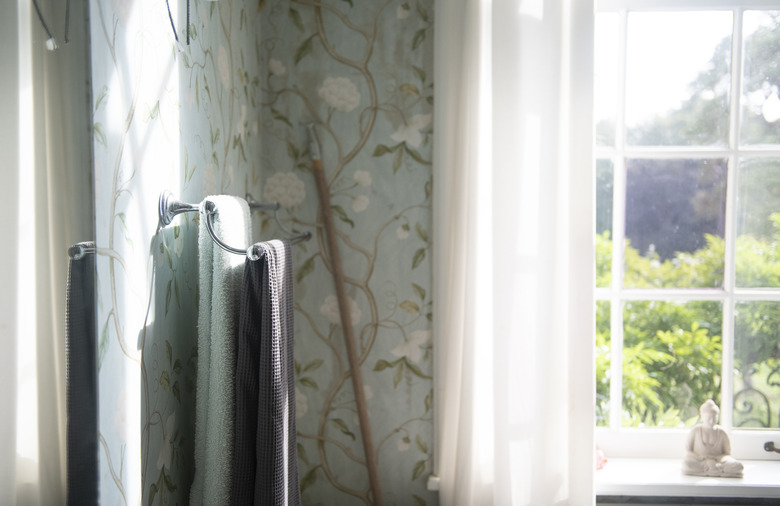How To Remove Wallpaper From Behind A Toilet Tank
We may receive a commission on purchases made from links.
Removing outdated or unwanted wallpaper can be a chore. When it is plastered to the wall behind the toilet tank or other nook that is difficult to reach, it can be a challenge. Removing old wallpaper from behind a toilet tank takes a little finesse and the proper tools.
Prep and Tools Needed
Prep and Tools Needed
The problem may be on the wall, but the solution may soak your flooring. Prep the area by putting down some old towels and plastic painter's film behind the toilet under the wall on which you'll be working. Secure the floor coverings with painter's tape so that you don't slip while working on the wall. Cover any wall outlets that are near the toilet with painter's tape to protect them from any overspray from the wallpaper remover.
The tools you'll need include a plastic putty knife, a wallpaper scoring tool, safety goggles, a screwdriver, vinegar, fabric softener and a spray bottle.
Removing the Tank
Removing the Tank
To remove the wallpaper behind the toilet tank, you need to access it. Turn off the water supply to the toilet at the valve below the tank. Remove the tank's top and flush the water from the tank. Dry out the tank with a wet/dry shop vac or old towels.
Unscrew the coupling to the water supply line that leads to the tank and remove the bolts that hold the tank to the bowl. Place the tank in an area outside the bathroom so that you have enough room to work.
First Steps to Removing Wallpaper
First Steps to Removing Wallpaper
Locate a piece of wallpaper that has lifted from the wall and push the edge of the putty knife under the wallpaper. Don't press the putty knife too hard into the wall or you may end up with gouges that will need to be repaired.
Slowly lift the wallpaper piece at a 45-degree angle while pushing the putty knife below it. Remove as much of the wallpaper in strips as you can.
Removing Stubborn Wallpaper
Removing Stubborn Wallpaper
Most wallpapers have an outer layer of vinyl, bamboo or textile. Below that is an inner layer that is typically just paper. The outer layer of wallpaper can be hard to remove. Lightly run the wallpaper scoring tool over the remnants to perforate the top layers.
Mix 1/4 cup of fabric softener with 3/4 cup of hot water in a spray bottle and douse the area. You can also use a solution of 1/3 cup of white vinegar with 2/3 cup of hot water. Let the mix sit on the wall for a few minutes to perforate the top layer and soak into the paper beneath.
Use the plastic putty knife to scrape off the wet remnants. If you come across any dry areas, simply spray on the solution and move on to other areas while it soaks. Put the pieces in a trash bag to keep the small space as clean as possible. When working in tight spaces, such as behind a toilet, the work area should be kept clean to cut down on the risk of an accident.
Removing Adhesive From the Wall
Removing Adhesive From the Wall
After completing all that work to remove the wallpaper, there's still one more step. The adhesive can leave behind a grungy film. Use the same solution to scrape off the adhesive. As you scrape off the adhesive, wipe down the wall to remove the residue. Continue this process until all of the wallpaper and adhesive have been removed.
